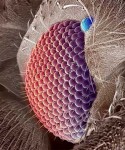The Mega-Catch™ A to Z of Mosquitoes, Mosquito Bites and Mosquito Control
Everything you ever wanted to know about mosquitoes in the one place!
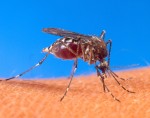 We know that not all mosquitoes bite humans. Some bite both animals and humans and some only bite humans. However, all biting mosquitoes have one thing in common, they’re female, and they’re simply after nourishment (in the form of a blood meal) for their eggs.
We know that not all mosquitoes bite humans. Some bite both animals and humans and some only bite humans. However, all biting mosquitoes have one thing in common, they’re female, and they’re simply after nourishment (in the form of a blood meal) for their eggs.
The fact that mosquitoes have been around, surviving and thriving since Jurassic times, indicates just how smart these little biters are. So while it may not be possible to eradicate them completely, with a better understanding of this perennial pest, there are ways we can at least outsmart them.
A – Attraction
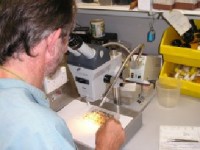 Scientists have discovered that 1 in 10 people are highly attractive to mosquitoes and that 85% of susceptibility comes down to genetics. Certain elements of the body’s chemistry attract mosquitoes and because each person’s chemistry is unique, some people are more prone to bites than others. Mosquitoes find pregnant women, people who produce excess amounts of uric acid or have high concentrations of steroids on the skin particularly appealing. Movement and heat also attract mosquitoes.
Scientists have discovered that 1 in 10 people are highly attractive to mosquitoes and that 85% of susceptibility comes down to genetics. Certain elements of the body’s chemistry attract mosquitoes and because each person’s chemistry is unique, some people are more prone to bites than others. Mosquitoes find pregnant women, people who produce excess amounts of uric acid or have high concentrations of steroids on the skin particularly appealing. Movement and heat also attract mosquitoes.
“Mosquitoes use odor to sort the attractive people from the unattractive people to find those that are most tasty,” according to University of Florida entomologist Dr Jerry Butler. “They are looking for the highest rates of human attractants.”
B – Bites
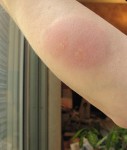 Despite the term, mosquitoes don’t actually bite. They pierce the skin with their proboscis to get at the blood vessels just beneath it. That red, itchy bump that appears is the body’s allergic reaction, and not the result of a tiny wound.
Despite the term, mosquitoes don’t actually bite. They pierce the skin with their proboscis to get at the blood vessels just beneath it. That red, itchy bump that appears is the body’s allergic reaction, and not the result of a tiny wound.
Each person’s allergic reaction to a mosquito bite varies. Some people actually become relatively immune to them with repeated exposure, while others become even more sensitive. Children are especially vulnerable to allergic reactions from mosquito bites. Some people can have a serious reaction to mosquito bites, which results in swelling in the throat, significant hives and wheezing. While rare, this life-threatening condition (anaphylaxis) requires immediate medical attention
C – CO2
 The mere act of breathing in and out attracts mosquitoes. Mosquitoes have receptors so sensitive they can detect the smell of carbon dioxide (CO2) in a person’s breath from as far away as 50 meters. As you exhale, CO2 and other odors mix to produce a plume that travels through the airstream inviting mosquitoes to swarm closer. Larger people tend to give off more CO2 which is why mosquitoes typically prefer adults to small children. Pregnant women also produce a greater-than-normal amount of exhaled CO2 making them more of a target.
The mere act of breathing in and out attracts mosquitoes. Mosquitoes have receptors so sensitive they can detect the smell of carbon dioxide (CO2) in a person’s breath from as far away as 50 meters. As you exhale, CO2 and other odors mix to produce a plume that travels through the airstream inviting mosquitoes to swarm closer. Larger people tend to give off more CO2 which is why mosquitoes typically prefer adults to small children. Pregnant women also produce a greater-than-normal amount of exhaled CO2 making them more of a target.
D – DEET
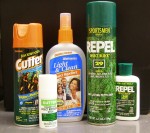 Considered one of the most effective mosquito repellents around (and one of the oldest) DEET was first developed for use by the U.S. Army in 1946, and became available to the public in 1957. Scientists have been puzzled for many years by how DEET actually works. One theory, based on how biting insects use chemical, visual, and thermal cues to locate hosts, suggests that DEET works by blocking the chemical receptors for carbon dioxide and lactic acid, two of the substances released by our bodies that serve as attractants. However, University ofCalifornia researchers believe mosquitoes flee because of their intense dislike for the smell of the chemical repellent, and not because DEET jams their sense of smell. Whatever the reason, DEET (short for N,N-diethyl-meta-toluamide) is the most widely used insect repellent in the world for a very good reason – it works really well!
Considered one of the most effective mosquito repellents around (and one of the oldest) DEET was first developed for use by the U.S. Army in 1946, and became available to the public in 1957. Scientists have been puzzled for many years by how DEET actually works. One theory, based on how biting insects use chemical, visual, and thermal cues to locate hosts, suggests that DEET works by blocking the chemical receptors for carbon dioxide and lactic acid, two of the substances released by our bodies that serve as attractants. However, University ofCalifornia researchers believe mosquitoes flee because of their intense dislike for the smell of the chemical repellent, and not because DEET jams their sense of smell. Whatever the reason, DEET (short for N,N-diethyl-meta-toluamide) is the most widely used insect repellent in the world for a very good reason – it works really well!
E – Environmentally-friendly
EnviroSafe Technologies, a privately owned company based in Auckland, New Zealand, developed one of the first environmentally friendly mosquito traps. Unlike conventional mosquito traps which rely on various chemicals to attract mosquitoes, Mega-Catch’s™ patented, scientifically proven mosquito traps employ a wide range of stimuli to lure, capture and kill mosquitoes.
F – Foggers
 Yard foggers and sprays are one way of getting rid of mosquitoes – temporarily! And unfortunately because they’re not mosquito-specific, they usually end up killing everything else including many beneficial insects as well as bees and butterflies. There’s also been a lot of discussion on the role of insecticides in agriculture and how they may have contributed to resistance in mosquito populations (CDC).
Yard foggers and sprays are one way of getting rid of mosquitoes – temporarily! And unfortunately because they’re not mosquito-specific, they usually end up killing everything else including many beneficial insects as well as bees and butterflies. There’s also been a lot of discussion on the role of insecticides in agriculture and how they may have contributed to resistance in mosquito populations (CDC).
G – Garlic
Spraying garlic to keep insects away isn’t something new; farmers have been doing it for generations. Mosquito Barrier is a strong liquid garlic spray made from very potent or ‘super garlic’ cloves. Since mosquitoes are soft-bodied insects, the garlic juice can be very toxic to them in strong concentrations. The juice is not harmful to humans, pets or plants – but to mosquitoes it can be deadly.
H – HIV
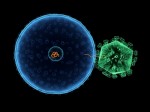 According to Rutgers, mosquitoes cannot transmit HIV. They actually digest the virus, so it does not replicate, and it is broken down before it can be transmitted to someone else. Also, mosquitoes pass such minuscule amounts of blood when biting that infection is not possible.
According to Rutgers, mosquitoes cannot transmit HIV. They actually digest the virus, so it does not replicate, and it is broken down before it can be transmitted to someone else. Also, mosquitoes pass such minuscule amounts of blood when biting that infection is not possible.
I – Integrated Mosquito Management
Dr Janet McAllister (Center for Disease Control and Prevention) emphasizes the need for public awareness in identifying and eliminating anything that may be adding to a mosquito problem. Her web seminar, “What is an Integrated Mosquito Management Program?” refers to the importance of using products available on the domestic market such as mosquito repellents and mosquito traps.
J – Juniper
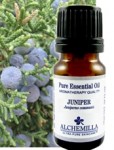 Various essential oils are effective in repelling mosquitoes including juniper. Juniper oil is used in many familiar products like shampoos and soaps as well as OTC insect repellents like OFF Deep Woods and Badger anti-bug balm. If you are into a bit of DIY you can make your own repellent; combine 2½ tsp juniper oil with 1 cup of 190-proof grain alcohol (available in your local liquor store). Place both ingredients in a jar, shake to combine then transfer the mixture to smaller spray bottles.
Various essential oils are effective in repelling mosquitoes including juniper. Juniper oil is used in many familiar products like shampoos and soaps as well as OTC insect repellents like OFF Deep Woods and Badger anti-bug balm. If you are into a bit of DIY you can make your own repellent; combine 2½ tsp juniper oil with 1 cup of 190-proof grain alcohol (available in your local liquor store). Place both ingredients in a jar, shake to combine then transfer the mixture to smaller spray bottles.
K – Kill
 There’s lots of ways to kill mosquitoes, from high tech traps and lasers (Rocket Scientists Shoot Down Mosquitoes With Lasers) to something as mundane as the clothes on your back. Permethrin-treated clothing both repels and kills mosquitoes and will remain effective even after repeated washes.
There’s lots of ways to kill mosquitoes, from high tech traps and lasers (Rocket Scientists Shoot Down Mosquitoes With Lasers) to something as mundane as the clothes on your back. Permethrin-treated clothing both repels and kills mosquitoes and will remain effective even after repeated washes.
A recent innovation, the LarvaSonic acoustic larvicide system kills mosquitoes at the larval stage before they can morph into fully fledged biting adult mosquitoes. Sound energy transmitted into water at the resonant frequency of the mosquito larvae air bladders instantly ruptures the internal tissue and causes death.
L – Lactic Acid
 Scientists have known for years that lactic acid—present on human skin—is a mosquito attractant. Many skin care products contain lactic acid; with lotions and creams labeled “alpha hydroxy” containing the highest concentrations.
Scientists have known for years that lactic acid—present on human skin—is a mosquito attractant. Many skin care products contain lactic acid; with lotions and creams labeled “alpha hydroxy” containing the highest concentrations.
M – Malaria
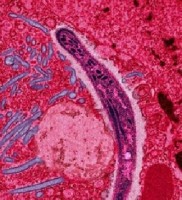
The Anopheles mosquito transmits malaria which, according to the World Health Organization, kills up to 3 million people every year.
Symptoms of malaria include fever, headache, and vomiting, and usually appear between 10 and 15 days after the mosquito bite. If not treated, malaria can quickly become life-threatening by disrupting the blood supply to vital organs. In many parts of the world, the Plasmodium parasites which cause malaria have developed resistance to a number of malaria medicines.
N – Netting
Mosquito nets offer good personal protection and can be used to surround a bed, gazebo, or favorite chair. But remember the second you step out of that ‘safe zone’, you are at risk.
O – Octenol
 Octenol, sometimes described as ‘cow’s breath in a can’, is remarkably attractive to mosquitoes and other biting insects who can detect this chemical from almost 100 feet away. While Octenol itself does not kill insects, when released into the air, it attracts mosquitoes. Some, but not all mosquito species are attracted to Octenol, however studies have determined it is effectiveness against the potentially deadly Zika-transmitting Aedes aegypti mosquito. Octenol is not harmful to humans, other non-target organisms, or the environment.
Octenol, sometimes described as ‘cow’s breath in a can’, is remarkably attractive to mosquitoes and other biting insects who can detect this chemical from almost 100 feet away. While Octenol itself does not kill insects, when released into the air, it attracts mosquitoes. Some, but not all mosquito species are attracted to Octenol, however studies have determined it is effectiveness against the potentially deadly Zika-transmitting Aedes aegypti mosquito. Octenol is not harmful to humans, other non-target organisms, or the environment.
P – Permethrin
Permethrin is primarily a fast-acting insecticide and has some repellent activity as well. Sprayed onto clothing, mosquito nets, sleeping bags, tents etc. it can be effective for up to two weeks, even through washing. Permethrin should never be applied directly to the skin.
Q – Quinine
Quinine, a medication used in the treatment of Malaria, works by stopping the parasite from reproducing. Malaria, caused by a parasite called Plasmodium, is transmitted via the bites of infected mosquitoes. In the human body, the parasites multiply in the liver, and then infect red blood cells.
R – Repellents
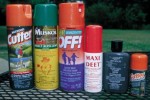 Repellents do not kill mosquitoes, but they will help deter them from biting people, however bear in mind that repellents do not protect all users equally. The effectiveness of a repellent depends on the mosquito species that is biting, as well as the age, sex, level of activity, and attractiveness (to mosquitoes that is) of the human using the repellent. The strength of the formulation determines how long you’re protected against mosquito bites i.e. a 10% DEET based repellent may provide 2 h protection; a 20% formulation may provide 4 h protection.
Repellents do not kill mosquitoes, but they will help deter them from biting people, however bear in mind that repellents do not protect all users equally. The effectiveness of a repellent depends on the mosquito species that is biting, as well as the age, sex, level of activity, and attractiveness (to mosquitoes that is) of the human using the repellent. The strength of the formulation determines how long you’re protected against mosquito bites i.e. a 10% DEET based repellent may provide 2 h protection; a 20% formulation may provide 4 h protection.
The U.S. Centers for Disease Control (CDC) recommends only those products containing the following active ingredients:
- DEET
- PICARIDIN by Bayer (marketed as CUTTER ADVANCED)
- OIL OF LEMON EUCALYPTUS (marketed as Repel)
- IR3535 marketed as Avon Skin So Soft
S – Source Reduction
An efficient way to control mosquitoes is to find and eliminate their breeding sites:
- Destroy or dispose of tin cans, old tires, buckets, bird baths, unused plastic paddling pools or other containers that collect and hold water. Do not allow water to accumulate in the saucers of flowerpots or in pet dishes for more than 2 days.
- Keep grass mown, bushes trimmed and debris out of the gutters throughout the mosquito season.
- Eliminate standing water in low spots, ditches and other areas.
T – Traps
Mosquito traps started out being used by entomologists and mosquito control agencies for trapping and surveillance purposes. Nowadays there’s a wide range of commercially available mosquito traps being used in backyards across America to help reduce and eliminate mosquito populations.
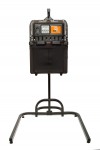 The style of trap varies by brand, but generally they range from indoor units the size of air purifiers to large units that resemble barbecue grills. Some run on low voltage electricity while others are powered by batteries or propane tanks.
The style of trap varies by brand, but generally they range from indoor units the size of air purifiers to large units that resemble barbecue grills. Some run on low voltage electricity while others are powered by batteries or propane tanks.
According to the American Mosquito Control Association, effective mosquito management requires integrating a variety of available control strategies i.e. surveillance, source reduction, biological control methods, traps, environmentally friendly larvicides, and, when necessary, application of public health adulticides. And while the organization does not endorse specific products, it reports that, “traps represent an evolving technology that is a most welcome addition to the mosquito control armamentarium”.
U – Ultra
One of the most advanced and effective mosquito traps on the market – the Mega-Catch™ Ultra doesn’t use pesticides or propane and can attract mosquitoes from as far away as 150 ft.
 This multi-attractant trap uses an integrated lighting display to produce light in the visible and invisible spectrum at oscillating frequencies known to attract most mosquito species. It also has a heat profile as well as using optional baits (Mega-Catch™ Fragrance Strips) to make it more effective. There’s also the option of a CO2 gas attractant system which can increase capture rates by as much as 300-400%.
This multi-attractant trap uses an integrated lighting display to produce light in the visible and invisible spectrum at oscillating frequencies known to attract most mosquito species. It also has a heat profile as well as using optional baits (Mega-Catch™ Fragrance Strips) to make it more effective. There’s also the option of a CO2 gas attractant system which can increase capture rates by as much as 300-400%.
This enables this machine to mimic human respiration by slowly releasing or ‘exhaling’ small quantities of CO2 into the air.
V – Vegetation
Many of the essential oils that act as mosquito deterrents can also work to repel mosquitoes in their vegetative form. Grasses and plants like citronella, geraniums and marigolds can be planted in your yard, garden and landscaping to add a little extra mosquito protection.
W – West Nile Virus
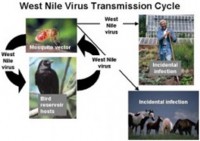 Carried by birds and spread by infected mosquitoes, West Nile Virus (WNV) has killed hundreds of millions of birds and infected more than 29,000 people in the U.S. since the first reported outbreak there in 1999. Most people infected with West Nile virus do not have symptoms. Others have mild symptoms. In rare cases, infection can lead to inflammation of the brain and the spinal cord (or the tissues surrounding it). Unfortunately there’s no vaccine forWest Nile virus – although research is currently underway to develop one. The only way to avoid WNV is to avoid getting bitten.
Carried by birds and spread by infected mosquitoes, West Nile Virus (WNV) has killed hundreds of millions of birds and infected more than 29,000 people in the U.S. since the first reported outbreak there in 1999. Most people infected with West Nile virus do not have symptoms. Others have mild symptoms. In rare cases, infection can lead to inflammation of the brain and the spinal cord (or the tissues surrounding it). Unfortunately there’s no vaccine forWest Nile virus – although research is currently underway to develop one. The only way to avoid WNV is to avoid getting bitten.
X – X-Ray Vision
Mosquitoes don’t have x-ray vision; instead these high tech hunters have two compound eyes – large rounded globes covered with tiny individual lenses that pick up movement and color, as well as ocelli or simple eyes, which sense light waves.
Y – Yellow Fever
A flavivirus originally common to primates in Africa and South America, yellow fever, like dengue fever, is transmitted by Aedes mosquitoes, especially Aedes aegypti (the yellow fever mosquito).
The virus incubates in the body for three to six days before an infected person begins to show the common infection symptoms of fever, chills, headache and nausea. There may be a short remission before the disease returns with much more serious symptoms such as nosebleeds, bloody vomit and abdominal pain.
 While there is no treatment for yellow fever, it is possible to be vaccinated against infection for those living in or traveling to climates where the disease is prevalent.
While there is no treatment for yellow fever, it is possible to be vaccinated against infection for those living in or traveling to climates where the disease is prevalent.
Z – Zappers
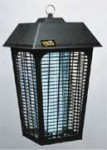 While zappers do kill a large number of insects, studies have found that most of them are moths and beetles, and less than 7 per cent are mosquitoes. In fact, yards with zappers typically have no fewer mosquitoes than yards without zappers.
While zappers do kill a large number of insects, studies have found that most of them are moths and beetles, and less than 7 per cent are mosquitoes. In fact, yards with zappers typically have no fewer mosquitoes than yards without zappers.
